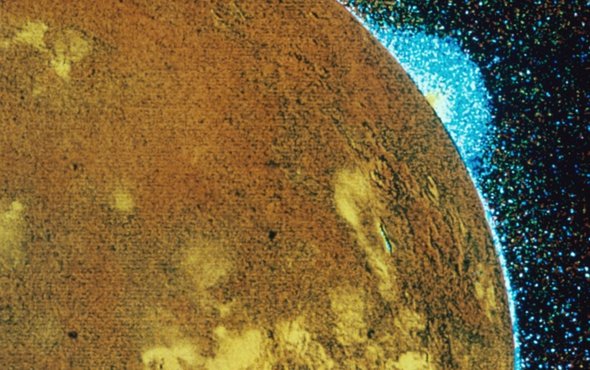(单词翻译:单击)
听力文本
This is Scientific American — 60-Second Science. I'm Julia Rosen.
In the last few decades, astronomers have discovered thousands of exoplanets orbiting other stars. Now, scientists want to know what they look like. Do they have oceans? Atmospheres? Researchers have even searched for signs of plant life and the glow of alien city lights—although they haven't found any yet.
"We've moved on from being excited about finding exoplanets to now having to get our kicks out of characterizing them."
Moiya McTier, a graduate student at Columbia University and the host of the podcast So You Think You Can Science.
Last year, McTier's advisor challenged her to find something else on exoplanets: evidence of extraterrestrial mountains. Because mountains could offer clues about what's going on inside these planets.
"The way that those form is through the collision of tectonic plates or through lava building up in the same place over millions of years. And so that's one of the most exciting things, in my opinion, that can come out of this project, is actually being able to figure out what's underneath the surface of an exoplanet."
The trick was how to do it. Modern telescopes are powerful, but they can't capture pictures of exoplanets. Instead, a common way astronomers detect them is by watching as they pass in front of their star, blotting out some of the light. McTier riffed on this idea to find a way to look for mountains.

"And so, what we are doing with this mountains project is saying, okay, if a planet has a mountain on it and if that planet is rotating, then the mountain will show up in silhouette. And the silhouette will change, because the planet's rotating. So, we can study that changing silhouette—that changing shadow—to get an idea of what the surface of the planet looks like."
McTier tested the technique by modeling how the rocky planets of our solar system would look through modern telescopes like the James Webb if they were far away.
"And we were pretty heartbroken when found out that it wouldn't be possible."
But McTier calculated that it might be doable with something like the Extremely Large Telescope, which is currently under construction in Chile. Even this telescope probably wouldn't be able to measure the topography of a Mars-like body if it orbited a large star like our Sun. But if that planet circled a smaller star, like a white dwarf, it would block out enough light to be detectible. The research is in the Monthly Notices of the Royal Astronomical Society.
So, one day soon we may be able to confirm the existence of exoplanetary mountains. And with even better telescopes, maybe molehills. Or even moles.
Thanks for listening for Scientific American — 60-Second Science. I'm Julia Rosen.
参考译文
这里是科学美国人——60秒科学。我是朱莉娅·罗森。
在过去几十年的时间里,天文学家发现了数千颗围绕其他恒星运转的系外行星。现在,科学家想知道它们的样子。系外行星上有海洋吗?有大气吗?研究人员甚至还在寻找植物生命迹象和外星城市灯光,尽管他们尚未找到。
“我们已经从发现系外行星的兴奋感,转为现在不得不以去描述其特征为乐趣。”
莫伊亚·麦克蒂尔是哥伦比亚大学的研究生,也是播客《So You Think You Can Science》的主持人。
去年,麦克蒂尔的导师给了她一项挑战性任务:在太阳系外行星上寻找其他东西:外星山脉的证据。因为山脉可以提供这些行星内部情况的线索。
“这些山脉的形成是因为地壳构造版块的碰撞,或是由于岩浆历经数百万年在同一地点堆积而成。因此,在我看来,这项工程最令人兴奋的事情之一是,我们能了解系外行星表层之下的情况。”
关键在于如何去做。现代望远镜功能强大,但是不能捕捉到系外行星的图像。相反,天文学家探测系外行星的常用方法是,当它们经过恒星前方时,观察其遮光情况。麦克蒂尔依靠这个想法找到了寻找外星山脉的方法。
“因此,我们在这个寻找外星山脉项目中所做的就是,如果一颗行星上有山脉,如果那颗行星正在旋转,那山脉就会出现轮廓。而这种轮廓会变化,因为行星在旋转。所以,我们可以研究那个不断变化的轮廓,也就是不断变化的阴影,以此来了解该行星表面的样子。”
为了测试这项技术,麦克蒂尔用太阳系的岩石行星进行模拟实验,看看如果这些行星很遥远的话,那通过詹姆斯·韦伯等现代望远镜观察它们是什么样子。
“当我们发现这不可能时,的确非常伤心。”
但是麦克蒂尔推测,目前智利正在建设的极端巨大望远镜等设备或许可以执行这个项目。虽然如果类似火星这种物体围绕太阳这样的大型恒星旋转,那这个望远镜可能无法测量其地形。但是如果这颗行星围绕白矮星这种较小恒星旋转,那行星挡住的光线足以被探测到。这项研究结果发表在《英国皇家天文学会月报》上。
所以,不久的将来我们或许就能证实外星山脉的存在了。而利用更先进的望远镜,我们可能还会观察到鼹丘,甚至是鼹鼠。
谢谢大家收听科学美国人——60秒科学。我是朱莉娅·罗森。
译文为可可英语翻译,未经授权请勿转载!
重点讲解
重点讲解:
1. blot out 遮住;挡住;遮蔽;
About the time the three climbers were halfway down, clouds blotted out the sun.
当这3个登山者下到半山腰的时候,云层遮住了太阳。
2. show up 出现;
Its symptoms typically show up in early childhood. The main characteristics are inattention, hyperactivity and impulsivity.
其症状通常出现于孩童时期早期,主要的特徵是注意力不集中、过动和冲动。
3. in silhouette 呈侧面影像;呈黑色轮廓像;
Even from behind in silhouette, Billy recognized the figure.
即便看到的只是背影的轮廓,比利还是认出了那个人影。
4. block out 挡住,遮挡(光线);
Thick chipboard across the window frames blocked out the daylight.
装在窗框上的厚厚的胶合板挡住了白天的光线。


